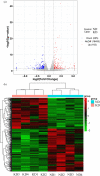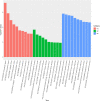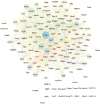Effect of ketogenic diet on exercise tolerance and transcriptome of gastrocnemius in mice
- PMID: 36852401
- PMCID: PMC9961969
- DOI: 10.1515/biol-2022-0570
Effect of ketogenic diet on exercise tolerance and transcriptome of gastrocnemius in mice
Abstract
Ketogenic diet (KD) has been proven to be an optional avenue in weight control. However, the impacts of KD on muscle strength and exercise endurance remain unclear. In this study, mice were randomly allocated to normal diet and KD groups to assess their exercise tolerance and transcriptomic changes of the gastrocnemius. KD suppressed body-weight and glucose levels and augmented blood ketone levels of mice. The total cholesterol, free fatty acids, and β-hydroxybutyric acid levels were higher and triglycerides and aspartate aminotransferase levels were lower in KD group. There was no notable difference in running distance/time and weight-bearing swimming time between the two groups. Furthermore, KD alleviated the protein levels of PGC-1α, p62, TnI FS, p-AMPKα, and p-Smad3, while advancing the LC3 II and TnI SS protein levels in the gastrocnemius tissues. RNA-sequencing found that 387 differentially expressed genes were filtered, and Cpt1b, Acadl, Eci2, Mlycd, Pdk4, Ptprc, C1qa, Emr1, Fcgr3, and Ctss were considered to be the hub genes. Our findings suggest that KD effectively reduced body weight but did not affect skeletal muscle strength and exercise endurance via AMPK/PGC-1α, Smad3, and p62/LC3 signaling pathways and these hub genes could be potential targets for muscle function in KD-treated mice.
Keywords: exercise tolerance; high-throughput sequencing; ketogenic diet; lipid metabolism.
© 2023 the author(s), published by De Gruyter.
Conflict of interest statement
Conflict of interest: Authors state no conflict of interest.
Figures









Similar articles
-
Combined Effects of Ketogenic Diet and Aerobic Exercise on Skeletal Muscle Fiber Remodeling and Metabolic Adaptation in Simulated Microgravity Mice.Metabolites. 2025 Apr 13;15(4):270. doi: 10.3390/metabo15040270. Metabolites. 2025. PMID: 40278399 Free PMC article.
-
Combined effects of a ketogenic diet and exercise training alter mitochondrial and peroxisomal substrate oxidative capacity in skeletal muscle.Am J Physiol Endocrinol Metab. 2021 Jun 1;320(6):E1053-E1067. doi: 10.1152/ajpendo.00410.2020. Epub 2021 Apr 12. Am J Physiol Endocrinol Metab. 2021. PMID: 33843280 Free PMC article.
-
Short-term and long-term ketogenic diet therapy and the addition of exercise have differential impacts on metabolic gene expression in the mouse energy-consuming organs heart and skeletal muscle.Nutr Res. 2018 Dec;60:77-86. doi: 10.1016/j.nutres.2018.09.004. Epub 2018 Sep 19. Nutr Res. 2018. PMID: 30527262
-
Ketogenic diets and protective mechanisms in epilepsy, metabolic disorders, cancer, neuronal loss, and muscle and nerve degeneration.J Food Biochem. 2020 Mar;44(3):e13140. doi: 10.1111/jfbc.13140. Epub 2020 Jan 14. J Food Biochem. 2020. PMID: 31943235 Review.
-
Ergogenic Properties of Ketogenic Diets in Normal-Weight Individuals: A Systematic Review.J Am Coll Nutr. 2020 Sep-Oct;39(7):665-675. doi: 10.1080/07315724.2020.1725686. Epub 2020 Feb 10. J Am Coll Nutr. 2020. PMID: 32039654
Cited by
-
Combined Effects of Ketogenic Diet and Aerobic Exercise on Skeletal Muscle Fiber Remodeling and Metabolic Adaptation in Simulated Microgravity Mice.Metabolites. 2025 Apr 13;15(4):270. doi: 10.3390/metabo15040270. Metabolites. 2025. PMID: 40278399 Free PMC article.
-
Exogenous Ketone Supplementation and Ketogenic Diets for Exercise: Considering the Effect on Skeletal Muscle Metabolism.Nutrients. 2023 Sep 30;15(19):4228. doi: 10.3390/nu15194228. Nutrients. 2023. PMID: 37836512 Free PMC article. Review.
-
Ketogenic diet in treating sepsis-related acquired weakness: is it friend or foe?Front Nutr. 2024 Nov 28;11:1484856. doi: 10.3389/fnut.2024.1484856. eCollection 2024. Front Nutr. 2024. PMID: 39668897 Free PMC article. Review.
References
-
- Buehler LA, Noe D, Knapp S, Isaacs D, Pantalone KM. Ketogenic diets in the management of type 1 diabetes: safe or safety concern? Cleve Clin J Med. 2021;88(10):547–55. - PubMed
LinkOut - more resources
Full Text Sources
Research Materials
Miscellaneous
